Come the month of March and spring begins its play of colours with the Nature around. This splash of colours heralds the festive mood in the lives of Mizos and they prepare themselves to celebrate Chapchar Kut, the festival of happiness. It is considered to be the most important traditional festival of Mizoram and is celebrated with great pomp and splendour.
The Mizos traditionally have three main festivals namely- Mim Kut, Pawl Kut and Chapchar Kut.
Origin
In the Mizo history around 1450-1700 AD a Kawlni chief ruled over a village called Suapui which was located within the territory of Myanmar. In those days the highest aspiration of every young man was to excel in the feat of strength, skill or bravery in the field or in hunting or even in sports. Often the chief or his son led youngmen to the village to war or to hunting expeditions. The villagers anxiously awaited the successful return of the hunting teams for whom a special meat and Zu (rice beer) were unusually prepared by them. It was followed by great rejoicing by the whole village.
As the legend goes, one fine spring morning the chief of Suapui led his village braves to a hunting expedition into a deep forest full of wild animals. The hunting expedition took several days. The villagers waited for the successful return of their warriors. Their biggest pots, full of locally made rice beer used to be ready to welcome the intrepid hunters returning with their booty. The village maidens were even more anxious, because they would then make ear rings, hair combs from the hones and teeth of the catches they would be bringing home.
But unfortunately the chief and his braves were not blessed by Chawngtinleri (the guardian queen of the beasts) and that made them return to village empty-handed to the deep despair of the welcome party. Understanding the shame and disappointment of his braves the chief instantly proposed an impromptu festival - made up with drinking beer and feast to lighten the gloomy mood of his braves. He himself showed up with a fat pig and a big rice beer pot asking each of his hunting mates to contribute fowls and beer pots.
A feast was thus prepared with meat aplenty and rice beer flowing. The village folks were also requested to join the feast. The spirits then went high and the mood changed from disappointment to merry making; young men and women joined hands and danced in circle; singing and clapping their hands all the while.
So the entire community enjoyed even more than they would have done had the hunters come back with rich booty. They would turn defeat into victory as it were and so all the folks joined in singing, dancing and merry making. Seeing the happy singing and delighted folks the Suapui village chief thought that it should be repeated every year at the same time. This gave birth to the most loved Mizo festival known as Chapchar Kut. The delightful dance called Chai also found its origin.
Celebration
In course of time, Chapchar Kut began to be celebrated in all the Mizo villages becoming a very important cultural tradition in the society. Each village developed its own brand of celebration to suit its own time, idiom and ethos over the years. The celebrations carried on for four to five days.
On the first day pigs were killed late in the day for feasting and on the next morning village elders including women spent the day drinking beer while young boys and girls were busy making preparations for singing and dancing. Old women used to carry cooked food and boiled eggs to feed the passers by at the entrance of the village usually under a banyan tree or near memorial stones.
The third day of Chapchar Kut festival is also termed as Chai Ni (dancing day). Young men and women dressed themselves in their best ornaments-necklace of amber, earrings of ivory and beautiful headband made of fine feathers. Boys and girls sang and danced all through the night forming circles in the chief’s yard.
The fourth day is called Zupui Ni (Zupui is a mild beer brewed with husks specially made for festive and special days) Zupui, contributed by various families, was passed around the whole day. Towards the evening, songs and dances got underway again lasting till the next morning.
The fifth day was solemnized as Zu Thing Chaw Ni. On this day all the contributed and collected Zu was to be finished. The sixth day used to be the day of siesta. Having fed themselves with meat and drinks to the brim they called it a day of rest. Hunting or going out of the village was considered a taboo.
The longest Chapchar Kut celebration in Mizo history was of the Chawngtui village. It went on so long that the entire village forgot its cultivation. This resulted in famine and the villagers dispersed to the neighboring villages.
These days the practice of mass feasting, drinking of locally-made beer and dancing throughout the night has died down. Now arrangements are made for presenting traditional dances of the Mizos. Colourful parading of different clans with their traditional proceedings almost parallels the Christian way of life.
Due to the efforts of worthy individuals, organizations and the State government, Chapchar Kut has now become the most popular and colourful cultural festival of Mizoram. The day is declared a gazetted holiday and is celebrated all over Mizoram.(PIB Features)
Mizos celebrating Chapchar Kut festival |
A Mizo couple in festive mood during Chapchar Kut festival |






No comments:
Post a Comment